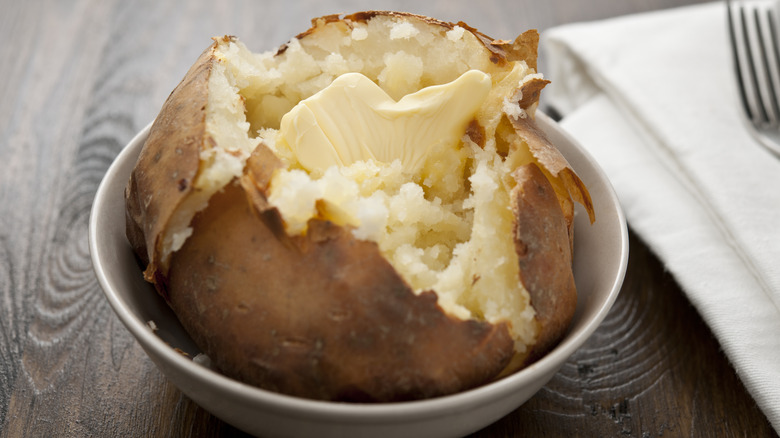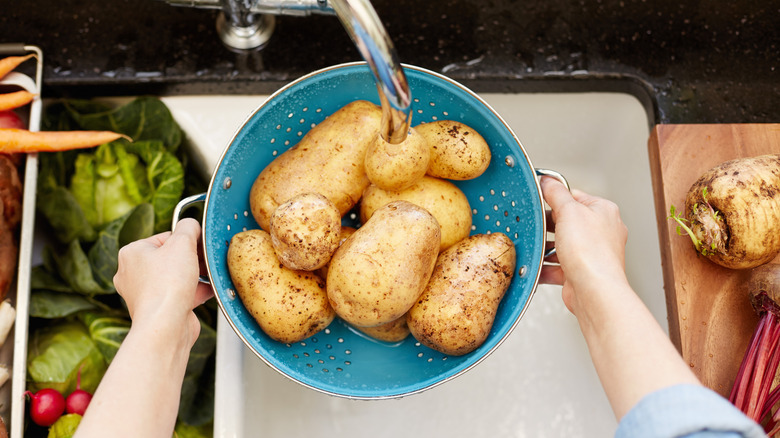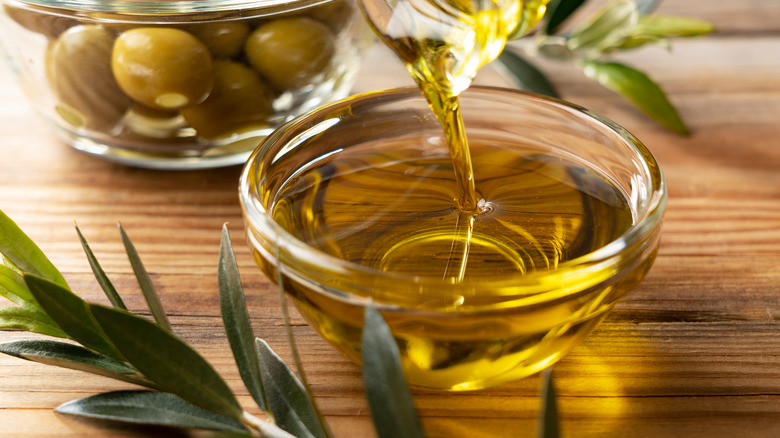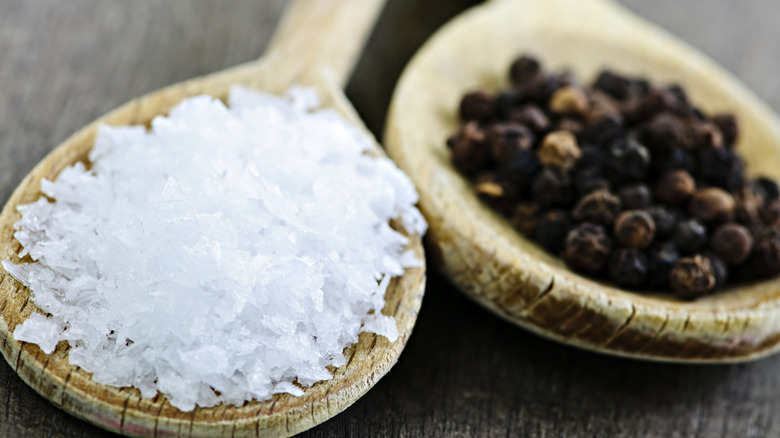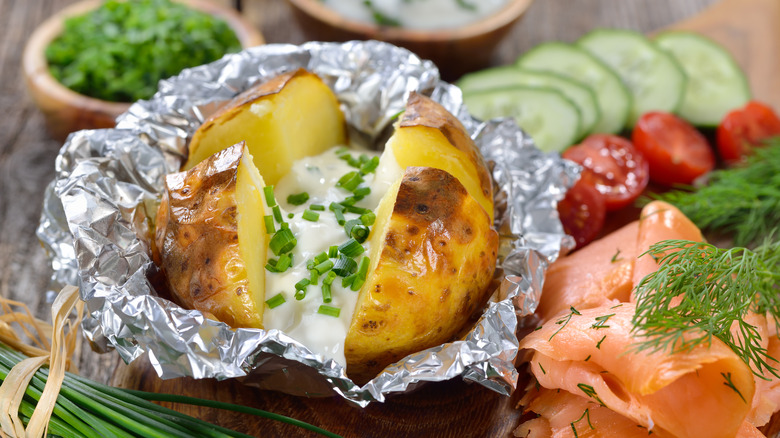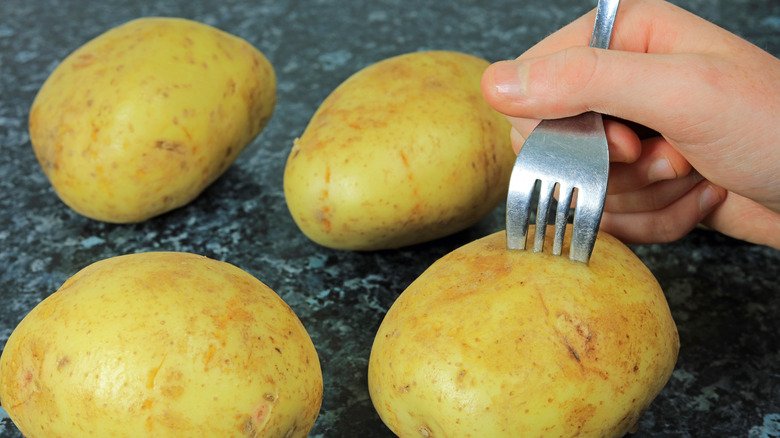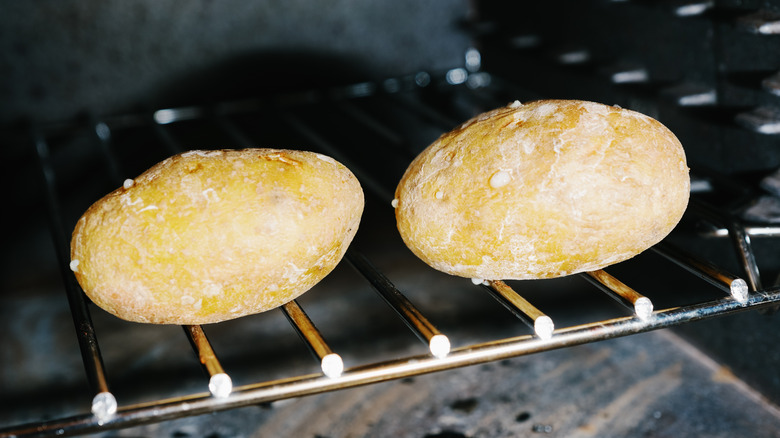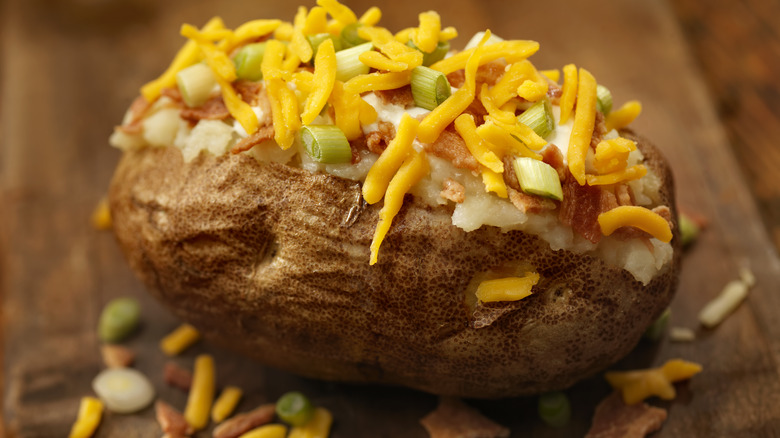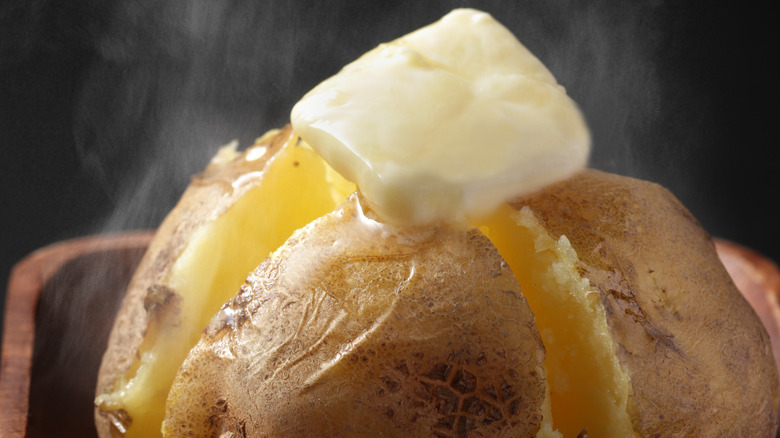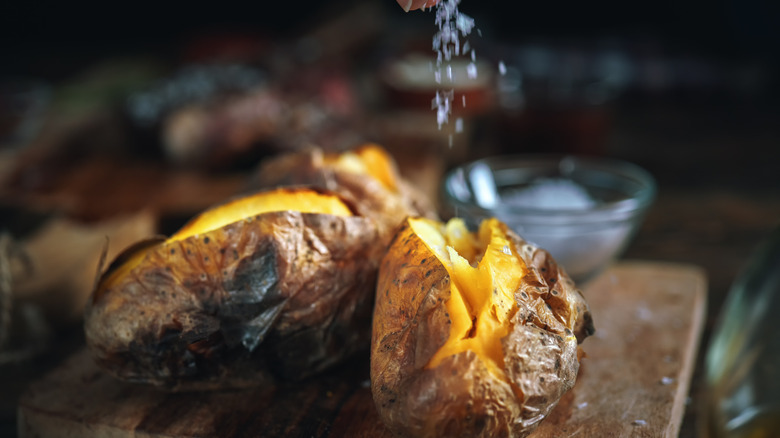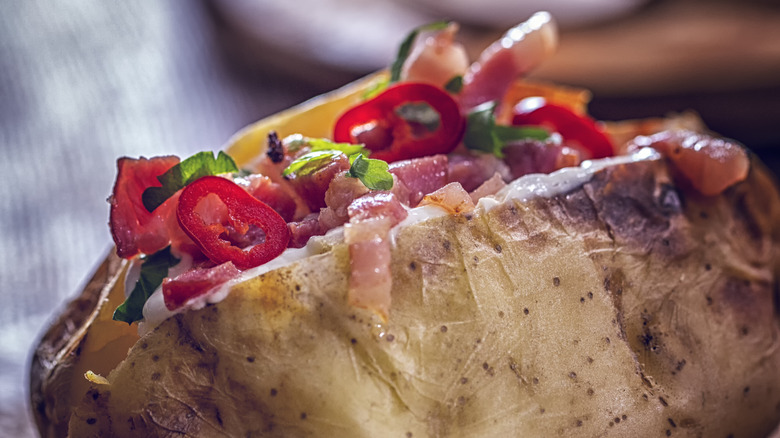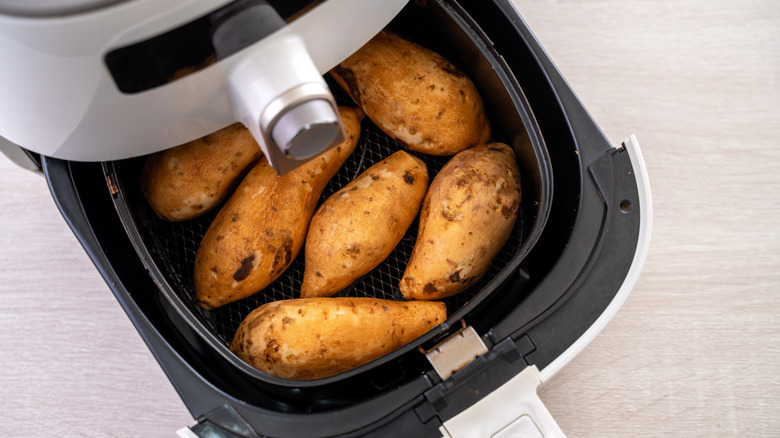13 Mistakes You Might Be Making With Baked Potatoes
Pretty much everyone likes potatoes, right? While we already know this, the popularity of potatoes is still pretty surprising. The number of metric tons of potatoes produced in 2021 alone clocked in at a whopping 376 million, according to Statista.
But it doesn't take a data expert to see why they're so popular. Potatoes are delicious, hearty, cheap, and full of a range of antioxidants, vitamins, and minerals, as well as a good amount of fiber, according to Healthline. If that wasn't enough, they're also versatile, slotting into everything from pasta to casseroles to tapas dishes. But our favorite style of potato has to be baked. Baked potatoes are the ideal base for a range of toppings.
But while baked potatoes are pretty simple to cook, they can still go drastically wrong. If you want a brilliant baked potato, you have to nail your technique. That's why we decided to put together a compilation of all of the mistakes that can occur when preparing baked potatoes, and how to avoid them.
1. Starting with the wrong potato
There's an incredible amount of diversity in the potato world regarding appearance and taste. From sweet and oddly-shaped sweet potatoes to golf ball-sized and waxy potatoes, these tubers come in virtually every shape, size, flavor, and texture you could desire.
But when baking potatoes, it's a different story. To get the perfect baked potato, you must start with the right variation, otherwise, you'll never end up with that fluffy texture and crispy skin that we all crave. Essentially, you need a good-sized potato from a low-moisture, high-starch variety. Russet potatoes are the standard choice — and for good reason. These potatoes grow to large sizes, have a high starch content, and are covered in a skin that crisps up excellently.
If you can't find Idaho® Russet potatoes anywhere, Idaho® Yukon Gold potatoes are also a great option, but you may find that they don't have the same fluffiness that the other varieties do. In reality, though, you can bake any potato, even the smaller ones.
2. Forgetting to dry your potatoes after washing them
Baking potatoes isn't as simple as taking them off the shelf and placing them directly in the oven. These plants have a habit of keeping deposits of dirt in their nooks and crannies, requiring you to give them a good scrub in warm water before cooking.
But once you've washed your potatoes, you better make sure you dry them, otherwise you'll have a disappointing end product. If you put your potato into the oven when still wet, it'll carry excess moisture. That moisture will then convert into steam, making the potato skin soggy instead of crisp, and potentially causing the inside of the potato to become too soft. A dry potato, on the other hand, will result in crispy skin.
The solution is simple: Grab a few pieces of paper towel, or a clean dishcloth, and wipe your potato until it's fully dry. To ensure that it's completely devoid of moisture, you can also then leave it out to air-dry for a while before you bake them.
3. Assuming you need to add oil before cooking
When you bake a potato, do you slather it in oil first? Most people do. Contrary to popular belief, you don't need to add any oil whatsoever before you bake a potato, and doing so might even give the meal flavors that you didn't want.
While you can add oil, there's really no need to. Most potatoes will crisp up just fine without it. What will happen, though, is that any oil you use will seep into the skin, and so if you coat your potato with a strong-tasting oil before cooking it, it will end up with additional flavor upon completion, something you may or may not want.
Adding certain types of fat can also end up ruining your baked potato entirely. Coating your potato with butter, for example, may not produce the flavor you might like. Butter has a low smoke point, so your potato can end up tasting acrid and burnt. Save your butter until after the potato is finished cooking.
4. Forgetting to season your potato
There is no denying that the basic flavor of potatoes is — for want of a better word — a little boring. While potatoes have a slight nuttiness and a gentle savory flavor that serves as the perfect base for sharper, stronger tastes, they can also get quite bland unless you dress them up a bit. Baked potatoes are particular culprits of this; under-seasoning them leaves you wanting more.
That's why you should always be seasoning your baked potatoes. Adding some salt is the bare minimum. It's a good idea to coat your potato with salt before cooking it, too. When you do this, the salt on the exterior pulls moisture out of the potato while it bakes, which then leaves you with a pillowy inside. Try using flaky sea salt for this. We also recommend lightly spraying your potato with cooking oil before applying the flaky salt. Using this type of salt, plus some oil, will help the seasoning cling to your potato.
Remember, too, that there's no need to stop at just salt, seasoning-wise. Cracked black pepper can add piquancy and spice, and rolling your spud in dried rosemary is a great way to give it a herbal, floral flavor.
5. Wrapping your potato in foil
The image of a baked potato wrapped snugly in foil is one that's common to a lot of people. Contrary to popular belief, this isn't the best way to cook baked potatoes. While it may keep them warm after cooking, it won't lead to the best result in the oven.
"I see a lot of people using foil to wrap their potatoes in but this is a big no-no and causes soggy skins!" New Orleans-based chef Isaac Toups told Today. When you wrap your potatoes in tin foil, you're essentially insulating them, creating an exterior barrier from which no moisture can escape. Where does all that moisture go? Straight back into the potato.
This can affect not only your potato skin but also your potato interior. Having too much moisture left in the flesh can lead to a wet, slightly gummy consistency. Instead, leave the foil off entirely, and bake your potato in all its naked glory.
6. Forgetting to prick your potato
Pricking your potato with a fork before baking it is, for many, a time-honored ritual. But in your haste to get your tuber into the oven, you can forget to perform this step. On the other hand, somewhere down the line you may have heard that it's really not that essential, and you can just throw your potatoes in without poking holes into the skin.
But we really recommend you don't skip this one. "Yes, it's good to prick them. It pokes holes in the skin, which allows steam to escape. Otherwise, they could explode — it doesn't happen all the time, but it happens every once in a while," warns the University of Idaho's School of Food Science faculty member Brennan Smith, via Food52. Since potatoes have a high water content, this water turns into steam when you cook them. If the steam doesn't have a way to get out, it builds up inside the potato flesh, which can cause the whole thing to burst.
Rather than face the possibility of that happening — and the resulting mess it would make in your oven — grab your fork and prick away. A few pricks on each side of the potato should do the trick.
7. Cooking your potato on a tray
To cook your potatoes, you need to put them on something. After all, you can't just throw them onto the floor of your oven and hope for the best. Whatever you do, don't put them on a flat tray. By placing your potato on a baking sheet, you'll apply too much heat to one very specific part of it: The side of the potato that's in contact with the hot metal. This could result in an unevenly-cooked potato, a partially burnt potato, or a tuber that's stuck to the tray.
To avoid this, you'll need to get yourself a wire rack — and we're not just talking about the racks that your oven comes with. This tool, which comes with wires that are more finely woven together — will allow the heat to properly circulate around your potato, cooking it from every side, resulting in a more even bake.
If you want to make sure it's completely perfect, you can also turn your potato halfway through cooking — just avoid opening your oven door too much, as you'll cause the heat to drop every time you do. If you don't have a wire rack, you can place your potatoes straight on the wire trays that come with your oven, but make sure that they're clean first.
8. Getting your temperature wrong
It can seem hard to get the temperature of a baked potato wrong. After all, they take quite a while to cook, so surely you just throw them in at a reasonably hot temperature, and when they're done, they're done, right?
Well, not quite. You do need to aim for a certain temperature when baking your potatoes, otherwise, you'll achieve an inconsistent bake. Too low, and your potato will be underdone. Too high, and you run the risk of your potato becoming overbaked, leaving it tough and possibly burned.
Instead, aim for the sweet spot. The best temperature to bake your potatoes at is 400 degrees Fahrenheit, this level of heat is just enough to cook them all the way through and crisp up on the outside, without going overboard. Most large potatoes will take approximately 1 hour to cook, although you might need slightly longer if your potato is especially large. Smaller potatoes may not need as long. We recommend checking them every 10 minutes or so after around the 45-minute mark to make sure you take them out at the right time.
9. Not checking to see if it's done
It can be hard to know when a baked potato is done by just looking at it. Aside from a change in appearance on the exterior, there's nothing that really indicates whether the flesh inside is perfectly soft, or still raw. To figure it out, you'll have to dive deep into the interior of your potato. Luckily, there are two pretty foolproof methods for checking if it's finished.
The first is to use a meat thermometer – or another type of food thermometer that has a sharp probe attachment. By inserting this into your potato, you can check whether it has reached the right temperature and doneness without having to slice it open. Once the deepest point of your potato reaches 210 degrees Fahrenheit, it should be good to go.
If you don't have a thermometer, you just need another piece of trusty kitchen equipment, you can also use a knife. Push a sharp knife into the potato, and if it slides through without any effort, that means that it's ready to go.
10. Letting your potato rest
Have you ever left your baked potatoes to rest? If so, you're not alone. But while allowing your baked potatoes to sit for a few minutes after taking them out of the oven might let them cool down slightly — taking the edge off their piping-hot temperature — it may also alter the consistency of your food.
"Another common mistake is letting the potato rest or cool before cutting. This is not meat and the potato doesn't get better with resting," chef Isaac Toups told Today. Instead, what happens is that the potato interior starts to get sticky and slightly wet. Rather than be faced with a substandard potato after all that cooking time, slice it open as soon as you can. The steam escaping will contribute to the fluffy consistency that you're craving.
But if you're not ready to eat your potato and need to keep it warm, then we can understand why you'd want to avoid cutting it open. If that's the case, simply keep the potatoes warm, then avoid microwaving them when you heat them back up — this can cause them to cook even more.
11. Slicing it incorrectly
Once your baked potato is ready, you're probably itching to eat some. But before you take that first forkful, you need to perfect your slicing game first. Cutting open baked potatoes wrong is a common occurrence: Way too many people simply make a big gash down the center of it, push it apart, then add their toppings.
While this can work, it can cause you to miss out on that maximum fluff factor. There is a technique for cutting a potato to achieve this. First, cut your potato lengthwise (parallel with the length), then follow this up with a perpendicular cut (across the width). This should make a cross shape of cuts. Then, take your potato on each end, and scrunch your potato in on itself slightly. By doing this, you create a well for the fillings to go into. You also fluff up the flesh considerably better than if you just have a single cut going through it, thanks to the friction caused when pushing everything together.
12. Being uncreative with your toppings
The worst thing you can do to a baked potato is make it boring. The beauty of a baked potato is that it's a simple meal that pairs well with not-so-simple toppings. While there's sometimes nothing better than a spud topped with some melted cheese and butter, why not mix things up a little?
Try upgrading baked potato night by making Italian-style potatoes. Make yourself a caponata — a relish consisting of fried eggplant, tomatoes, and onions — and spoon it on top of your potatoes. Next, top it with some shredded mozzarella or parmesan, and a sprinkling of parsley.
If you want to make things seriously spicy, homemade chickpea curry (with a dollop of chutney on top) will make your midweek meal much more interesting. As baked potatoes go so well with steak, why not combine the two? Slice up some skirt steak, then layer it on top of your potato. Top the whole thing with a blue cheese dressing, or simply some garlic salt. The only limits are your imagination.
13. Neglecting to use your microwave or air fryer
The only negative thing about baked potatoes is how long they can take. This simple dish can take upwards of an hour to cook, leaving you to get hungrier and hungrier as you wait. But one big mistake is just assuming that baking is the only way to cook your potatoes. You can bake a potato in 20 minutes with this hack involving a piece of kitchenware sitting right on your counter: Your microwave. Prick your potato, and then blast it on high for approximately 90 seconds, which will kick off the cooking process. You then need to transfer it to a piping-hot oven, where it'll take just 20 minutes to finish cooking.
If you want to forego your microwave and your oven entirely, you can use your air fryer. Air fryers are superb at developing extra-crispy skin on the outside of the potato while ensuring that it's cooked through. All you need to do is pop your potatoes in the fryer, set it to 400 degrees Fahrenheit, and let it cook for 30 minutes or so. After half an hour, the potatoes should be finished, but if you need a little more time, blast them for 5 to 10 more minutes.
